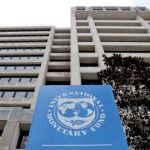ISLAMABAD:
Pakistan’s public debt may rise to 90% of national economy or Rs37.7 trillion by June this year and its balance of payments situation may worsen due to severe health and economic shocks in the aftermath of the deadly pandemic, a new International Monetary Fund (IMF) report reveals.
In its report, the IMF has disclosed that Pakistan will have to increase its collection of petroleum levy by 65% to Rs489 billion and tax collection by 31% to Rs5.1 trillion in the next fiscal year, if the country is keen to keep the troubled $6-billion loan programme on track.
For the current fiscal year, the IMF has projected Federal Board of Revenues (FBR)’s tax collection at only Rs3.908 trillion, lower than even the last fiscal year.
As against the original target of Rs5.555 trillion, the FBR is now projected to collect Rs1.65 trillion less than the target due to the impact of Covid-19, inefficiency of the revenue board and setting of an unrealistic target.
The IMF report also revealed that contrary to the prime minister’s announcement of Rs1.25-trillion economic relief package, the actual size of the “fiscal stimulus package (was) worth 1.2% of GDP (Rs500 billion)”.
Despite acknowledging that next fiscal year 2020-21 will also be tough for Pakistan’s economy, the IMF has sought fiscal consolidation efforts to the tune of Rs1.05 trillion or 2.5% of gross domestic product (GDP) on the back of again a steep expected increase in tax revenues.
The global lender on Friday released the report prepared for approval of a $1.4-billion emergency loan.
It said public finances were expected to come under significant pressure. The IMF report showed the primary deficit – total expenditure excluding interest payments – at 2.9% of GDP or Rs1.2 trillion for the current fiscal year. For the next fiscal year starting July, the IMF has projected the primary budget deficit at 0.4% of GDP or only Rs191 billion.
“The Covid-19 shock will unfortunately reverse the decline in public debt in recent months on the back of authorities’ fiscal consolidation efforts,” said the report.
Instead, public debt is projected to increase to around 90% of GDP or Rs37.7 trillion in FY 2020, against 85% or Rs35.6 trillion prior to the shock, due to a sharp decline in growth and an increase in budget deficit, according to the IMF.
The IMF said Pakistan’s debt sustainability was supported by the agreed rollover of maturing obligations by key bilateral creditors like China, Saudi Arabia and the UAE.
It said a more severe impact of Covid-19 than projected or the authorities’ failure to return to the path of consolidation may put fiscal sustainability at risk.
The report projected next fiscal year’s FBR target at Rs5.1 trillion. The target will be Rs1.131 trillion or 31% higher than the expected collection of Rs3.908 trillion in the current year.
The petroleum levy target for next fiscal year is now projected at Rs489 billion. The original target was Rs300 billion that in post-corona situation is still kept at Rs295 billion despite a slump in global oil prices to the lowest level in 20 years.
This shows that the government does not have a plan to pass on the reduction in oil prices to the consumers in this and next fiscal year.
Fiscal “projection that the (IMF) team has put together assumes that policies and reforms envisaged under the Extended Fund Facility programme will be implemented in different areas, including tax collection, power sector, state-owned enterprises and public finance management,” Teresa Daban, IMF Resident Representative, told The Express Tribune.
She was requested to comment why the IMF had again proposed unrealistic targets despite acknowledging that economic conditions would be tough in the next fiscal year.
The IMF said economic growth was expected to remain tepid in the first half of next fiscal year, depending on the success of efforts to contain the spread of the pandemic in Pakistan and worldwide, and to return gradually to faster growth in the second half of the year in line with the expected global recovery.
Cumulatively, real GDP growth had been revised down by five percentage points for FY 2020-21, said the IMF.
It cautioned that downside risks to the outlook were high given the unusual uncertainty about the duration and magnitude of the outbreak and the persistence of measures to contain it.
Pakistan is facing unprecedented health and economic shocks from the Covid-19 outbreak. In this fiscal year, economic activity is expected to contract for the first time since 1952 as GDP growth may contract by 1.5%, it added. While the fall in oil prices and weaker import demand provide some support to the current account, the Covid-19 shock will have a severe impact on the balance of payments, said the IMF.
In particular, export growth is likely to come to a halt due to the fall in external demand; remittances are expected to drop by over $5 billion during FY 2020 and FY 2021 as activity in Gulf Cooperation Council (GCC) countries declines; and outflows from non-resident holdings of domestic treasuries could continue, it said.
The IMF said the balance of payments scenario would result in new external financing needs of about $2 billion in the fourth quarter alone.







